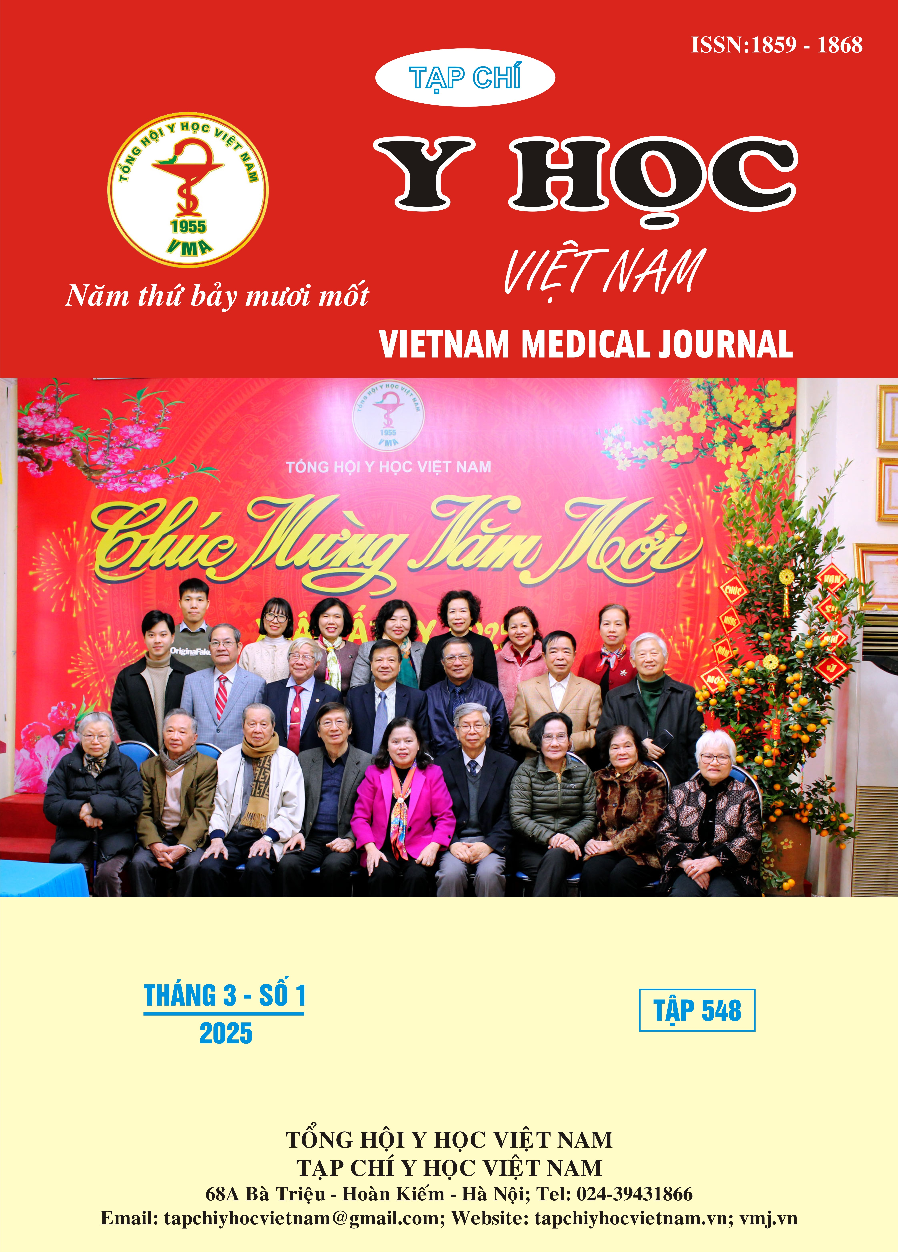CHARACTERISTICS OF TEMPOROMANDIBULAR JOINT BEFORE AND AFTER 6 MONTHS OF TREATMENT WITH STABILIZATION SPLINT (SS) ON CBCT IMAGING IN ADULT PATIENTS WITH TEMPOROMANDIBULAR JOINT DISORDERS (TMD)
Main Article Content
Abstract
Objective: Evaluation of certain indices on CBCT imaging in adult patients with temporomandibular joint disorders (TMD) after 6 months of treatment with stabilization splints (SS) in Hanoi City from 2022 to 2024. Subject and methods: A descriptive cross-sectional study on CBCT imaging in adults with temporomandibular joint disorders (TMD) treated with stabilization splints (SS), with imaging performed and analyzed at two time points: before treatment and 6 months after treatment. Results: The triangular condylar head morphology accounted for the majority (45,1%), while convex and round morphologies had the lowest proportion (9,7%). The dimensions of the posterior condylar space (PS) and superior condylar space (SS) were larger before treatment compared to 6 months after treatment. The proportion of patients without damage increased from 12,92% to 19,37% after treatment, while the prevalence of mild wear with cartilage thinning decreased from 41,93% to 35,48%. Conclusions: The distribution of condylar head morphology remained unchanged before and after 6 months of treatment. After 6 months of treatment, the condylar position shifted anteriorly and moved closer to the central position compared to before treatment. The majority of condylar head damage before treatment was in the form of wear with remaining cartilage.
Article Details
Keywords
Temporomandibular joint disorders (TMD), Stabilization Splint (SS)
References
2. Kazumi Ikeda (2009). Assessment of optimal condylar position with limited cone-beam computed tomography, Am J Dentofacial Ortho, 135, 495-501.
3. Peyron J.G, Altman R.D (1992). Osteoarthritis: diagnosis and medical/surgical management, Saunders, 2nd edition, 15-37.
4. Nguyễn Thị Thảo Vân, Võ Huỳnh Trang, Nguyễn Đức Minh (2022). Đặc điểm hình thái khớp thái dương hàm trên bệnh nhân rối loạn khớp thái dương hàm, Tạp chí Y dược học Cần Thơ, 49, 192-198.
5. Jaime Gateno (2004). A comparative assessment of mandibular condylar position in patients with anterior disc displacement of the temporomandibular joint, J Oral Maxillofac Surg, 62, 39-43.
6. Nguyễn Văn Tâm, Nguyễn Thị Thu Phương, Nguyễn Thị Thuý Nga (2021). Đặc điểm xương trên hình ảnh cắt lớp chùm tia hình nón của bệnh nhân rối loạn khớp thái dương hàm và mối tương quan với triệu chứng lâm sàng, Tạp chí Y học Việt Nam, 505(1), 151-154.
7. Võ Thị Lê Nguyên, Nguyễn Thị Kim Anh (2016). Hình ảnh Conebeam CT khớp thái dương hàm của bệnh nhân rối loạn khớp thái dương hàm tại khoa Răng Hàm Mặt-ĐH Y dược ĐH TP HCM, Tạp chí nghiên cứu y học TP Hồ Chí Minh, 20(2), 82-89.
8. Trịnh Văn Duy và CS (2024). Đánh giá mối tương quan giữa triệu chứng và mức độ đau khớp thái dương hàm với hình ảnh cộng hưởng từ ở bệnh nhân có rối loạn nội khớp, Tạp chí Y học Việt Nam, 539(2), 317-321.
9. Nguyễn Mạnh Thành (2013). Đánh giá kết quả điều trị rối loạn khớp thái dương hàm bằng máng ổn định, Luận văn tốt nghiệp Bác sĩ Nội trú, trường Đại học Y Hà Nội.
10. Lê Nguyên Lâm, Nguyễn Phúc Vinh (2023). Đánh giá kết quả điều trị rối loạn khớp thái dương hàm bằng máng nhai tại BV Trường Đại học Y Dược Cần Thơ, Vietnam Journal of Community Medicine, 64(5), 223-231.


